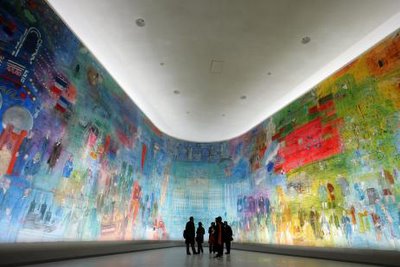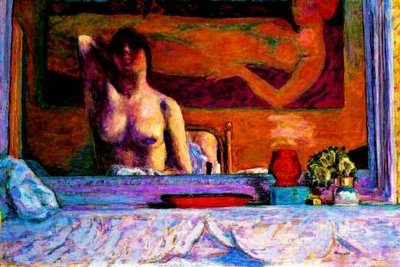Le Musée d'art moderne de la ville de Paris
 As I reported almost one year ago (Musée d'Art Moderne Set to Reopen in Paris, February 24, 2005), the Musée d'art moderne de la ville de Paris, closed for renovations since 1999, would open again this year in its old home in the east wing of the Palais de Tokyo. Well, it actually happened, with a Pierre Bonnard retrospective, Pierre Bonnard, L’oeuvre d’art, un arrêt du temps (90 paintings, plus many other works). An article by Armelle Héliot (Pierre Bonnard : maître de la peinture vivante, February 3) in Le Figaro was the first review I read (my translation):
As I reported almost one year ago (Musée d'Art Moderne Set to Reopen in Paris, February 24, 2005), the Musée d'art moderne de la ville de Paris, closed for renovations since 1999, would open again this year in its old home in the east wing of the Palais de Tokyo. Well, it actually happened, with a Pierre Bonnard retrospective, Pierre Bonnard, L’oeuvre d’art, un arrêt du temps (90 paintings, plus many other works). An article by Armelle Héliot (Pierre Bonnard : maître de la peinture vivante, February 3) in Le Figaro was the first review I read (my translation):
The Musée d'art moderne de la ville de Paris as one encounters it these days is not just one more institution in the rich cultural landscape of France, Europe, or the world. What Suzanne Pagé and her teams have managed to do is give an even stronger character to this institution. The renovation, although they were extensive, were not so violent that one no longer recognizes the same vast rooms one used to walk through. But the installation has been rethought, singular notes have been added here and there. You will no longer wander through these rooms as you do in New York, Saint-Etienne, or London. The collection, in its very singularity, is deployed to stunning effect. No, all modern art museums are not created equal, and the one in Paris is unique. Pierre Bonnard is there in the fullness and audacity of work whose force immediately subdues you. Paintings, large decorative pieces, photographs, drawings, notebooks, the immense artist of the 20th century, from overwhelming joy to silent melancholy, has only one concern: painting itself. He is our contemporary.Philippe Dagen wrote another review (Bonnard, en grand et autrement, February 2) for Le Monde (my translation):
Our first thought is that Bonnard is a strange choice. Bonnard has only a moderate reputation. No one denies that he painted voluptuous paintings. But was really a modern painter or just a postimpressionist who strayed into the 20th century, in whose work we see neither revolution or drama? Picasso's cruel assessment has stuck to his work: "A pot-pourri of indecision." [...] Once again, [curator Suzanne Pagé] has succeeded brilliantly. She convinces us to take a closer look at Bonnard, forgetting the banalities repeated about his smoothness. Bonnard is neither that simple nor that pleasant. He is often the inverse: complicated, unpredictable, difficult to penetrate. Visitors, who are coming in great number, will have that experience from the first room. Your gaze is thrown up against L'Homme et la Femme, a vertical canvas from 1900. A screen divides it into two equal halves. On the right, the nude man begins to put his clothes back on. On the left, crouching on the bedcovers, also fully nude, the woman caresses her foot. The cats have just come back onto the bed after having been chased away by the lovers' movements. So many details observe by a neutral eye that records what is presented to it, including the man's bad mood, the woman's boredom. What should be an erotic painting is a stifling one.
 The articles about the reopening have piled up over the last few days, including another review by Hervé Gauville (Un Bonnard intense, February 2) in Libération. One of the things that I wrote about last year was the incredible amount of work required in dismantling, decontaminating (from asbestos), and reassembling the immense installation by Raoul Dufy, La Fée Électricité (1937) -- 250 wood panels with oil paint -- now lit from the floor as the artist wanted. An article by Harry Bellet (Désamianter "La Fée Electricité", February 5) for Le Monde describes the process of decontamination, which was painstaking work. The new lighting scheme was designed by Georges Berne. At the same time as the joyous reopening, there are further plans for the Palais de Tokyo. Again, Harry Bellet published an article (Le Palais de Tokyo va s'agrandir, February 7) in Le Monde (my translation):
The articles about the reopening have piled up over the last few days, including another review by Hervé Gauville (Un Bonnard intense, February 2) in Libération. One of the things that I wrote about last year was the incredible amount of work required in dismantling, decontaminating (from asbestos), and reassembling the immense installation by Raoul Dufy, La Fée Électricité (1937) -- 250 wood panels with oil paint -- now lit from the floor as the artist wanted. An article by Harry Bellet (Désamianter "La Fée Electricité", February 5) for Le Monde describes the process of decontamination, which was painstaking work. The new lighting scheme was designed by Georges Berne. At the same time as the joyous reopening, there are further plans for the Palais de Tokyo. Again, Harry Bellet published an article (Le Palais de Tokyo va s'agrandir, February 7) in Le Monde (my translation):The second phase of the renovation of the Palais de Tokyo, in Paris, will cost 18 million euros, announced the Minister of Culture and Communication, Renaud Donnedieu de Vabres, on February 3. The building extends over 20,000 square meters, of which only a third is today occupied by the Site de création contemporaine, opened since 2002. The future Cité de la création contemporaine will host exhibits consecrated to living artists and creators on the French scene, including filmmakers and designers.I'll keep an eye on that as it develops.






















































3 comments:
Wow! the 2nd bonnard is brilliant, litterally. Ca't wait to visit the Dufy. I never knew of it. I learn Sooo much at ionarts!
I see an ionarts funded trip in my future. Crash therapy.
I will be in Paris in March. Count on a report about this.
Post a Comment